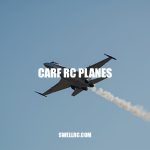The Ultimate Guide to Micro Remote Control Airplanes
The first time a 30‑gram foam wing lifted off my living‑room rug, I felt that kid‑again rush—pure wonder wrapped in clever engineering. Micro remote control airplanes are tiny, lightweight radio controlled planes—often palm‑size to backpack‑friendly—that compress everything we love about RC planes into small, accessible packages. Compared with mini RC airplanes, micros tend to be lighter, have a shorter wingspan, and are tuned for tighter spaces and calmer air.
Ultra‑Micro eXtreme designs, like many found in UMX airplanes, pushed this category forward with advanced stabilization tech and efficient power systems. Why are they trending? Portability, affordability, and an easy entry point into small RC aircraft.
After tinkering with different micro remote control airplanes kits, I finally understood what makes them soar so smoothly: low wing loading, smart stabilization, and just enough power to make every hallway a runway. This micro flight experience truly redefines the joy of indoor RC planes, making radio controlled planes accessible for enthusiasts of all ages.
Section One: Understanding Micro Remote Control Airplanes
Understanding how micro RC planes work reveals a fascinating balance of weight, power, and control. At the heart of these tiny radio controlled planes are power systems featuring either brushed coreless motors or tiny brushless outrunners, paired with lightweight ESCs—often integrated—to maximize efficiency. Most micro electric RC airplanes run on 1S 150–300 mAh LiPo batteries, with some performance models stepping up to 2S packs.
A modern 2.4 GHz transmitter communicates with micro receivers that cleverly combine gyro stabilization and AS3X/Safe-style assists on a single board. This integration significantly improves flight stability, helping to counteract wind disturbances and delivering smooth, precise control responses via servos. Typical micro models employ 3-channel controls (throttle, rudder, elevator), while more advanced ones add ailerons for enhanced maneuverability.
The airframes utilize durable EPP or EPO foam materials reinforced with carbon spars and taped hinges, optimizing the essential factor of wing loading. Achieving a large wing area with minimal mass slows flight speed, improves turning radius, and maintains linear tracking—allowing pilots to enjoy slow, steady flights with gentle stalls. Positioning the center of gravity at 25–33% of the wing chord ensures the airplane ‘locks in’ for stable handling.
| Aspect | Older micro models | Modern micro models |
|---|---|---|
| Stabilization | Little to none | Gyro/AS3X/Safe-style assists |
| Power system | Brushed, fixed-pitch props | Efficient brushless, optimized props |
| Materials | Depron/brittle foams | EPP/EPO foams with carbon spars |
| Flight time | 3–6 minutes typical | 6–12 minutes typical |
| Range | 30–80 m | 100–300 m |
| Control feel | Spongy, drift-prone | Precise, wind-tolerant for size |
Overall, small but critical improvements in receiver technology, servo resolution, and stabilization techniques have revolutionized how micro RC planes fly. The combination of careful weight management, advanced electronics, and aerodynamic design delivers a flight experience that is both accessible for beginners and rewarding for enthusiasts of electric RC airplanes.
Section Two: Best Micro RC Plane Models Worth Trying
After countless hours of flying different micro RCs—bouncing off gym walls, threading goalposts at dawn—these standouts kept earning battery after battery. If you’re searching for the best micro remote control airplanes for beginners, these models provide a fantastic blend of performance, ease of use, and durability.
- HobbyZone Sport Cub S 2 (Beginner): A SAFE-assisted 3-channel trainer that forgives over-control and thrives in calm parks. It’s an easy first pick for newcomers to electric RC airplanes.
- E-flite UMX Timber (Intermediate): Enjoy STOL (Short Takeoff and Landing) fun packed in a backpack-friendly size; equipped with slats, oversized wheels, and excellent slow-speed handling.
- E-flite UMX Radian (Beginner/Glider): A floaty thermal seeker that’s quiet, efficient, and surprisingly relaxing—ideal for glider enthusiasts.
- Volantex Mini Mustang 400 mm (Budget): Features a 3-axis gyro and stable tracking with inexpensive spares, offering great value for those venturing into RC model airplanes.
- Eachine Mini P-51 (Budget/RTF): Quick to assemble and a fun park burner, best flown when the wind is mild.
For hobbyists who love building, micro RC plane kits allow you to customize motors, servos, and foam strength to suit your flying style. Scale model fans should also explore the world’s smallest RC plane, a testament to extreme miniaturization. To better understand the boundary between micro and mini planes, be sure to browse best mini RC plane roundups—mini models generally offer a step up in size and wind tolerance, making them great for indoor RC planes and beyond.
Here’s a specs comparison table to help you weigh the options:
| Model | Type | Channels | Battery | Flight Time | Range | Price | RTF Level |
|---|---|---|---|---|---|---|---|
| Sport Cub S 2 | Trainer | 3 | 1S 150 mAh | 6–8 min | ~150 m | $120–$160 | RTF |
| UMX Timber | STOL | 4 | 2S 280 mAh | 5–8 min | 200–300 m | $170–$200 | BNF |
| UMX Radian | Glider | 3 | 1S 150 mAh | 7–12 min | ~200 m | $130–$160 | BNF |
| Volantex Mini Mustang | Warbird | 3 | 1S 360 mAh | 10–12 min | 100–200 m | $60–$90 | RTF |
| Eachine Mini P-51 | Warbird | 3 | 1S 400 mAh | 10–12 min | ~100 m | $50–$70 | RTF |
Whether you are just stepping into the world of RC flight or looking to upgrade your fleet, these micro remote control airplanes offer something for everyone, from beginners to more experienced pilots. Dive in and enjoy the skies with one of these outstanding models!
Section Three: Specialty Micro Aircraft & Performance Variations
Once you’re comfortable, the micro universe of remote control jets and micro RC helicopters gets wonderfully niche. Micro EDF jets feature tiny ducted fans that deliver that iconic jet whoosh with agile, high-speed passes, offering thrilling aerobatics but requiring higher skill levels and typically resulting in shorter flights. Meanwhile, micro RC helicopters fly on rotorcraft principles—coaxial rigs provide ultra-stable indoor flying, perfect for beginners, while single-rotor models offer precise cyclic control suited for advanced maneuvers.
Scale jets and warbirds, such as the micro versions of RC model airplanes like the RC F-35, bring impressive shelf presence and excitement when flown smoothly outdoors.
Flying clubs evaluating performance micro aircraft often look for clean tracking, axial rolls, coordinated turns, and proper weight-to-thrust balance. Collector groups, on the other hand, highly prize finish quality and scale details, including authentic decals, realistic canopies, and sharply defined panel lines, alongside solid flight performance.
Here are the top 3 niche builds worth considering:
- 35–50 mm micro EDF jet optimized for calm-air sprints, ideal for high-speed performance micro aircraft enthusiasts.
- Ultra-micro indoor 3D profile foamy equipped with a brushless 1102 motor on 1S battery for precise hover practice and advanced 3D aerobatics.
- Micro scale warbird featuring reinforced wing spars to handle park loops and rolls while maintaining scale authenticity.
Section Four: Buying Smart — Cost, Quality, and Value
Choosing the right micro plane involves balancing budget RC planes, skill levels, and the flying environment. For those seeking the most affordable micro remote control airplanes, budgets under $50 typically offer simple 3-channel Ready-to-Fly (RTF) trainers, ideal for backyard fun and beginners. Moving up, budgets between $100 and $200 open access to stabilized, durable models with brushless power and advanced flight assistance.
When deciding between RTF vs BNF options, beginners usually benefit from RTF packages that include radio, battery, and charger. Builders or pilots who already own a compatible transmitter might prefer Bind-N-Fly (BNF) or Plug-N-Play (PNP) kits to customize setups and save costs, enhancing their hobby experience through micro RC plane kits.
Durability plays a critical role — models constructed from EPP/EPO foam, featuring prop savers, and supported by widely available replacement parts ensure longevity even after inevitable nose-overs. Supporting components such as batteries, propellers, and servo linkages should be easy to source within your ecosystem, contributing to overall cost vs value.
Here’s a quick guide on budget tiers and what to expect:
| Budget | Typical models | Features |
|---|---|---|
| <$50 | 3‑channel trainers | Coaxial/gyro assist, RTF, short range |
| $50–$120 | Entry warbirds/trainers | Better gyros, tougher foam, easy spares |
| $120–$200 | UMX-class performance | AS3X/Safe-style aids, brushless power |
| $200+ | Specialty/collectible micros | Premium finish, advanced radios, spares kits |
To stretch value, consider browsing RC airplanes under $50 for giftable trainers and casual backyard flying, then graduate to stabilized 4-channel micros to enhance your flying skills.
Section Five: The Joy of Customization and Community
After joining a few online RC planes community groups, I realized the passion runs deep—people trade plans, swap props, and celebrate maiden flights like birthdays. Popular DIY RC mods that make small RC aircraft and indoor RC planes shine include prop-saver hubs, carbon-rod wing spars, foam-safe hinge tape, better linkages, and gyro tuning. Enthusiasts often incorporate foam mods and even add ultra-light FPV micro cameras for thrilling, close-quarters cruising.
For inspiration that spans scales and styles, world models RC planes (https://www.swellrc.com/world-models-rc-planes/) galleries are a rabbit hole worth exploring.
Where to find your crew:
- RCGroups micro and indoor forums
- Reddit communities like r/radiocontrol and r/fixedwing
- Local AMA clubs and indoor fun-fly nights
- Facebook and Discord groups dedicated to micro RC and indoor 3D
Every successful tweak teaches you something new—and that learning loop is half the joy of small RC aircraft. Embracing foam mods, gyro tuning, and FPV micro setups within an engaged RC planes community enriches your experience and skill in the hobby.
Conclusion: Taking Flight in the Micro RC Universe
Micro RC planes pack innovation in RC planes, accessibility and fun into a compact form factor you can easily carry in your backpack. From my earliest hallway takeoffs to serene calm-air park sessions, the discoveries keep unfolding—lighter packs, improved props, and steadier gyros enhance performance and enjoyment. The advantages of these remote control airplanes are clear: their compact designs, approachable prices, and endless opportunities for learners and hobbyists alike.
As electric RC airplanes evolve rapidly, each generation boasts longer flight times, straighter tracking, and greater resilience to bumps. By charging a few 1S battery packs, selecting a calm morning, and letting curiosity pilot your experience, you can enjoy thrilling flights even within a half basketball court space. Whether you’re flying beginner RC planes or more advanced micro RC models, the blend of innovation and accessibility makes this hobby incredibly rewarding.
- Compact and lightweight designs perfect for any environment
- Improved battery and propeller technology for extended flights
- Enhanced gyro stabilization ensuring steady and smooth control
- Affordable options catering to both beginners and seasoned pilots
| Feature | Benefit |
|---|---|
| Lightweight Packs | Longer flight times and easier handling |
| Better Props | Improved thrust and efficiency |
| Steadier Gyros | Smoother flight experience and stability |
| Affordable Prices | Greater accessibility for beginners and hobbyists |
Frequently Asked Questions
- What are micro remote control airplanes and how do they differ from mini RC planes?
Micro RC planes are very small, lightweight radio controlled aircraft—typically under about 250–400 mm wingspan and often under 100 grams—optimized for indoor spaces and calm outdoor air. Mini RC planes are a step up in size and mass, generally offering more wind tolerance, larger batteries, and longer range at the cost of portability. - Can micro RC planes fly outdoors or just indoors?
Both, but conditions matter. Micros excel indoors or outdoors in smooth air; aim for winds under about 5–8 mph, choose floaty gliders or STOL trainers for parks, and save windy days for larger models. - What are the best micro RC plane models for beginners?
Great starters include the HobbyZone Sport Cub S 2 (SAFE‑assisted trainer), E‑flite UMX Radian (gentle glider), and affordable 3‑channel gyro‑equipped warbirds like the Volantex Mini Mustang. They’re stable, durable, and easy to repair. - How long do micro RC airplane batteries last?
Typical flights run 5–12 minutes on 1S 150–300 mAh packs; efficient gliders can stretch to 10–15 minutes. High‑draw micro EDF jets may run closer to 3–5 minutes. - Are micro RC planes good for kids or only for hobbyists?
They can be kid‑friendly with adult supervision. Choose foam‑bodied, gyro‑stabilized, 3‑channel RTF trainers with prop savers, and fly in a safe, open area; older kids and beginners learn quickly with these setups. - What materials are micro remote control airplanes made of?
Primarily EPP/EPO foams reinforced with carbon rods or spars, plus lightweight plastics for canopies and linkages. Electronics include micro servos, integrated receiver/ESC boards, and single‑cell LiPo batteries. - How to maintain and store a micro RC plane after flying?
Disconnect and cool the battery, inspect hinges and linkages, wipe off dust, and check the prop and motor mount. Store in a dry box or original foam insert, keep LiPos at storage voltage, and transport in a protective case. - What’s the smallest functioning remote control airplane in the world?
Hobbyists have built palm‑size, gram‑class planes with single‑cell LiPos and sub‑gram receivers that genuinely fly for a few minutes. Records evolve quickly, but dedicated projects show just how far micro miniaturization can go.



